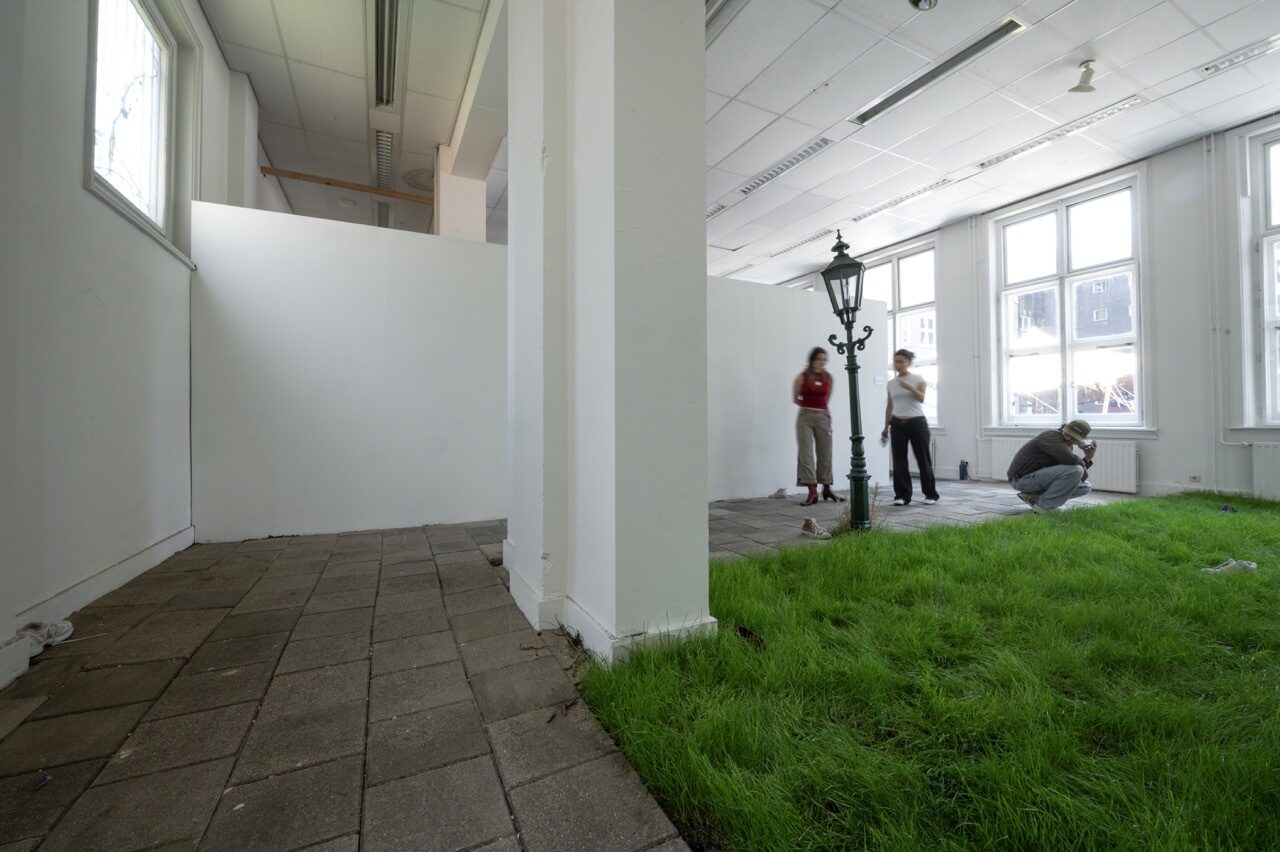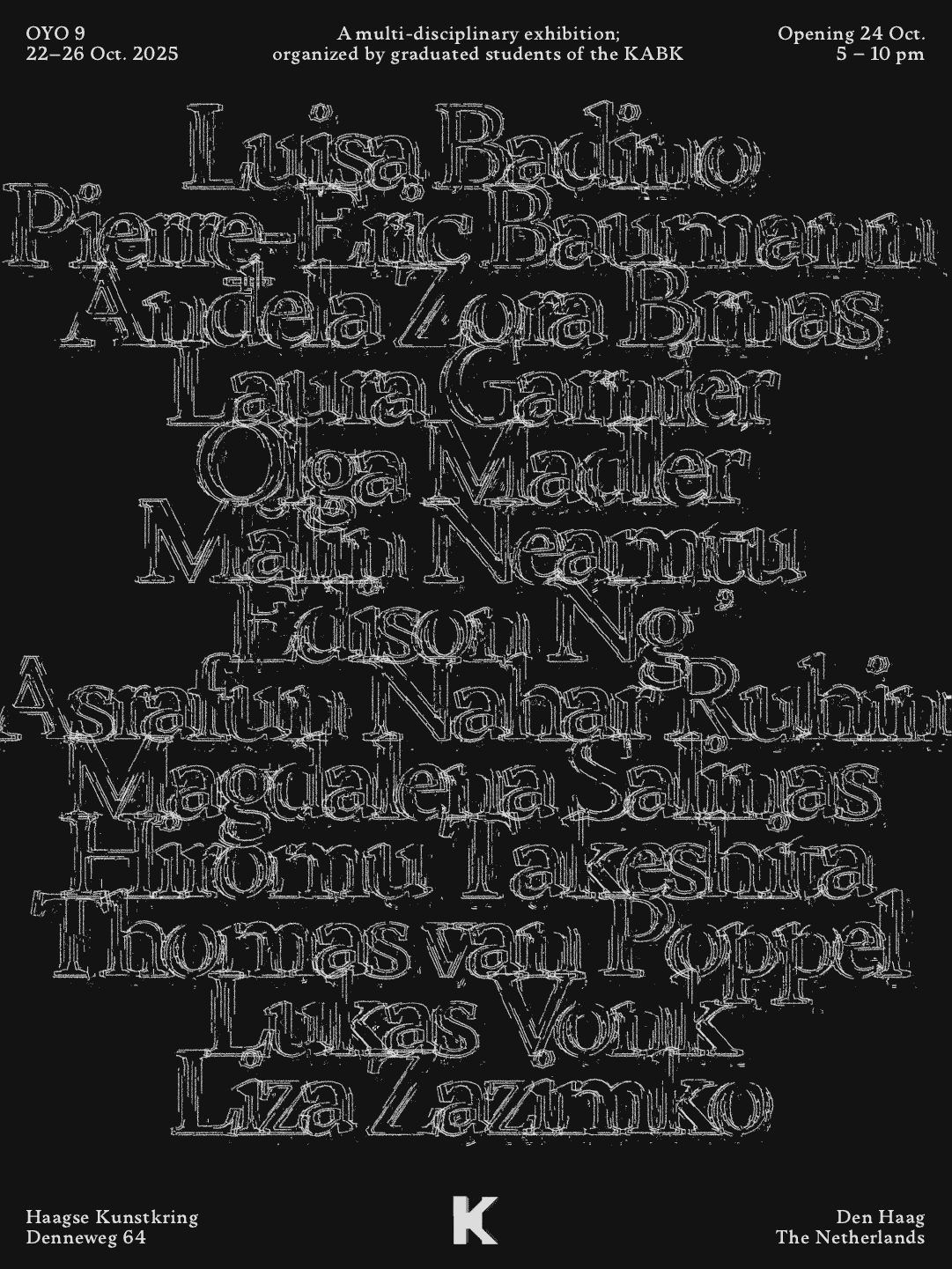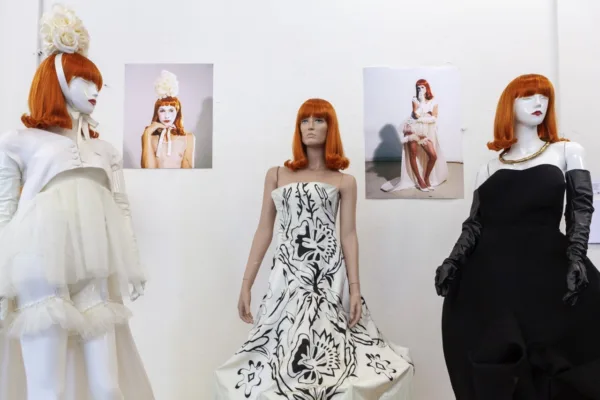Interactive art route in Kunstmuseum by KABK Graduates during Museum Night 2025
On 11 October, KABK graduates will participate in Museum Night with an interactive art tour through Kunstmuseum Den Haag. Visitors following the specially curated KABK route will encounter a diverse selection of artworks, each with a unique message. The artists will be present to provide insights and context about their works.
During Museum Night 2025 on 11 October you can view the work by Angele Jaspers (Graphic Design, 2025), Omer van Soldt (ArtScience, 2025), Kes Lugt (Fine Arts, 2025), Bessel Bloem (Textile & Fashion, 2025), Anaïs Lossouarn (ArtScience, 2025), Sonya Levchynska (Interior Architecture & Furniture Design, 2025) and Gjorgji Despodov (Non Linear Narrative, 2025) at Kunstmuseum Den Haag.
549. In everything I do lately, I feel that I am being tested. (true/false) by Angele Jaspers (Bachelor Graphic Design, 2025)
"Psychological tests are expressions of a deeply human urge to categorise and classify a world that inevitably resists such efforts. In their attempt to separate order from dis-order— obsessively, almost— , the psychologist may, in fact, not be so far removed from the designer— or the madman.
Shifting roles between tester, tested subject and designer, I aim to set the stage to explore the visual, textual and behavioral languages through which the troubled or ‘abnormal’ mind is required to speak its truth to the psychologist. By deconstructing, bending and recontextualizing existing psychological tests into a suitcase of playfully absurd tasks and objects, the project asks: who decides what kind of sense ‘makes sense’?"
The Self at 50HZ by Omer van Soldt (Bachelor ArtScience, 2025)
"My work is an invitation to the audience to make themselves unmistakably one with their environment.
The work consists of a rotating installation containing a symmetrical composition of 12 mirrors. By alternating the specific frequencies in rotation, the image can unify or completely eliminate the observer from view."
Found Shoes by Kes Lugt (Bachelor Fine Arts, 2025)
"For a long time, I have been intrigued by lonely lost shoes separated from their pair. How does anyone lose a single shoe? That is the question that started the work Found Shoes.
By integrating audio into these shoes, I try to explore the narratives hidden behind these objects stripped of purpose. The audio consists of speculative storytelling in the form of diaries written from the perspective of the shoes themselves."
Flor de la Peregrina by Bessel Bloem (Textile & Fashion, 2025)
"With "Flor de la Peregrina", I explore the intersection of identity, transformation, and self-expression through fashion. Rooted in personal experience and reflective research, the collection explores how function and emotion, practicality and memory can merge in unexpected ways.
In September 2024, I walked 780 kilometers across northern Spain on the Camino de Santiago — a spontaneous decision that became a deeply transformative journey. Freed from my daily routines and visual identity, I began to question how we define ourselves when external markers like clothing are removed. Who are we when we let go of how we present ourselves — and what do we uncover beneath?"
De Coeur en Choeurs by Anaïs Lossouarn (ArtScience, 2025)
“This tactile sound installation reveals the unseen connections between voice, heartbeat, and touch. Delicate copper wires, suspended from the ceiling, carry the recorded heartbeats of individuals who listened to the same sung melody. Subtly vibrating, they translate sound into movement; traces of an intimate resonance between body and voice.
A larger marble piece trembles with the singer’s heartbeat, captured as she sang. Visitors are invited to listen to the same melody through headphones and gently touch the marble fragments, feeling the pulse of distant, unseen listeners. The voice serves as a bridge, linking strangers through invisible rhythms. By touching the stones, you make contact with the internal echoes of others as their hearts progressively calm down, an intimate exchange between present and past, presence and absence.”
Allow Perching1 by Sonya Levchynska (Interior Architecture & Furniture Design, 2025)
Pim: Not everything is about a chair.
I: Yes, it is. It is everywhere: schools, offices, hospitality venues (cafes, restaurants), hospitals, cinemas, theatres, religious spaces, public transport, cars, and airplanes. This means people use a chair to eat, read, write, paint/draw, watch, listen, rest, travel, and as a shape for a toilet. Yet, it can lead to extinction.
Pim: Whose extinction?
I: Humans'.
How do chairs lead to extinction? Chairs lead to human extinction because of their specialized 2 aspects—cultural, structural, and functional.
Humans are inherently prone to discomfort. Standing still, sitting, lying down, or even moving for extended periods without feeling fatigued can be challenging. As a result, we shift positions—transitioning from one posture to another—in response to our previous actions to alleviate these basic discomforts. The need for movement and changes in posture is automatic and instinctive; it reveals our bodies’ adaptability. The chair denies this adaptability. It naturalizes one posture and limits bodily movement, while other postures—such as squatting, kneeling, or sitting cross-legged—are exoticized, marginalized, or associated with poverty or discomfort.
The freedom of bodily movement is necessary. Objects for both action and rest—designed at varying heights to offer different spatial perspectives—communicate through physical interaction while remaining ambiguous in their identity as furniture. These aspects challenge the specialization that the chair silently upholds.
(1) Perch - to alight, settle, or rest on a perch, a height, or a precarious spot.
(2) The association between specialization and human extinction echoes Buckminster Fuller’s claim in the Operating Manual for Spaceship Earth that “extinction occurs through specialization.”
Cache Cleanse by Gjorgji Despodov (Non-Linear Narrative, 2025)
“Welcome to the Cache Cleanse. Please leave your phones and algorithmic dependencies at the door. In this immersive installation, we enter a near-future scenario where the world is terminally online, and the collective consciousness is suffering from a little-known, absolutely-made-up-but-totally-real condition: Brain Rot.
Caused by chronic overconsumption of low-effort, low-quality, high-repeat media (meme dumps, TikTok loops, Reddit scrolls, that one girl explaining Plato through a Hailey Bieber lip gloss review), this condition leaves civilization drooling, dopamine-fried, and spiritually unwell. But worry not: in this world, we don’t abolish the Brain Rot—we treat it. Enter Cache Cleanse. This is not a spa. This is not a hospital. This is a fabulative materialization—part-therapy center, part-delulu chamber, part-speculative design proposal, but an entirely serious response to the collapse of attention and meaning. It replaces traditional wellness centers with community whisperers, anti-doom scrolling slime stations, and mood-based rituals. Envision a meditation session where instead of breathwork, you're softly instructed to "shhhh, swipe away." Imagine therapy, but your therapist is a softly-whispering voice repeating, "you are basically chronically chill."
The Cache Cleanse is not a product. It is not a solution. It is a provocotype—a prosthetic for the critical mind, designed to stretch our collective imagination around what care and content detox might mean in a world that cannot unplug. It doesn’t want to save you. It wants you to think about why you needed saving in the first place.”







